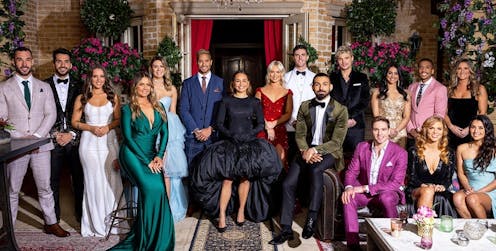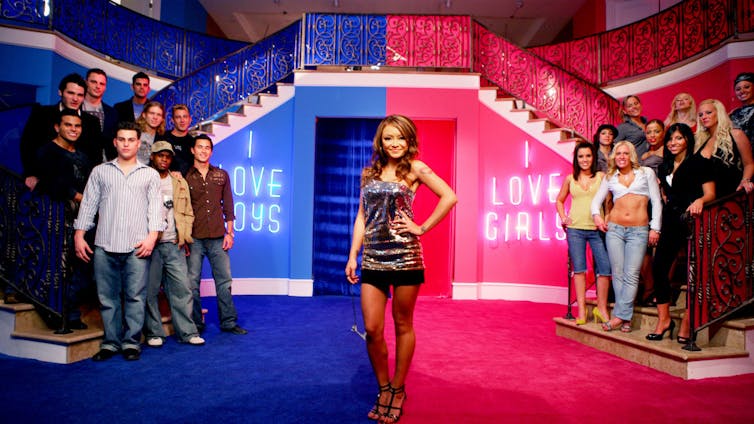Source: The Conversation (Au and NZ) – By Rebecca Beirne, Senior Lecturer in Film, Media and Cultural Studies, University of Newcastle

Reality TV staple The Bachelor, and its various franchises, has been described as a “primetime harem fantasy” even though it ultimately presents a fairly conservative portrait of romance.
In its latest iteration, The Bachelorette Australia (Network 10 2021) is attempting to offer something refreshingly different through the casting of Brooke Blurton, a First Nations bisexual woman. Such casting necessitates a first for the franchise — casting both male and female contestants to vie for Blurton’s affections.
Having both male and female suitors was sold as a groundbreaking moment of representation. One contestant even says “we’re doing so much for our community” in the second episode. Is this indeed the case? The volume and quality of representation we have seen of LGBTIQ+ individuals, characters and communities has undoubtedly improved, though it is still rare enough for each one to be notable.
Of course, the stereotypes and issues surrounding representing bisexuality are different from, say, those surrounding gay men. And it is well established by decades of research that television representation plays a role in informing attitudes towards LGBTIQ+ individuals.
The long and reductive history of bisexual representation on television
The Bachelorette is not the first series to present a bisexual individual on the small screen. 1990s bisexual representation on television was largely made up of ratings boosting kisses between a major female character and a non-recurring female character. In these cases, the major character’s interest in women was generally never mentioned again (think Ally McBeal, Picket Fences and even Friends). It was generally seen as a titillating or scandalous storyline, but not one that took representation or sexuality seriously.
Later on, series like Queer as Folk or The L Word, tended to characterise male bisexuality as simply a stopover on the way to gayness, with male bisexuals depicted as closeted or lying to themselves.
Neither of these positions take bisexuality particularly seriously as an identity. In the last few years we have seen two really positive representations emerge in the form of Rosa Diaz on Brooklyn 99 and David Schitt on Schitt’s Creek. Both of these characters built meaningful relationships with both men and women over the course of their seasons. And neither of them were defined purely by their sexuality.
In terms of reality dating television, as could perhaps be expected, representation of bisexuality has tended to emphasise sex. The casting of bisexual contestants can be seen to add an extra set of dimensions and complications. A recent example can be found in season 8 of MTV reality dating show Are You The One? (MTV 2019), which cast 16 male and female contestants who all identified as sexually fluid.
Perhaps the earliest reality dating series to feature both male and female contestants vying for a bisexual (female) lead was A Shot at Love With Tila Tequila (2007) and its 2008 sequel. In these series both male and female contestants were placed onto teams to compete for Tequila, who rose to fame as the most popular person on MySpace. The game structure even leveraged one woman and one man into the finale for Tequila to pick between. This emphasises the unfortunately common perception that bisexuals need to “pick a team”, and furthermore, that audiences should feel personally invested in what “team” that might be.

IMDb
The structure of reality dating shows with their emphasis on contest and conflict, tend to result in narratives that attempt to grab ratings with (often sexually charged) interactions between contestants. The issue with this is that it falls into a context of associating bisexuality with hypersexuality.
Read more:
Is The Bachelor anti-feminist, or is conventional heterosexual romance the real problem?
Brooke Blurton and bisexuality in 2021
The charming Brooke Blurton on The Bachelorette is characterised very differently from Tila Tequila. A statement from her, edited near the beginning of the premiere, asserts that she is interested in connections with individuals, rather than their gender. Thus eliminating the idea of there being a “team” for her to choose.
There are signs, however, that the series is setting up a men vs women narrative regardless of this. The first episode sees the male and female contestants grouped in separate gazebos, and multiple comments are edited in that highlight the various insecurities about having more than one gender in the mix. Blurton herself is also presented on multiple occasions making comparisons between the “boys” and the “girls”.
Certainly conventional perceptions around gender are still held by contestants and casting, such as surprise about the women being romantically “bold”, and the casting of only very stereotypically feminine women as suitors (in contrast, a fan favourite and finalist in Tila Tequila’s show was a relatively butch lesbian firefighter).
Read more:
If You Are The One and The Bachelor know how to get to us: we all fear dying alone
Osher Günsberg, The Bachelorette Australia’s host, is certainly self-congratulatory in his opening dialogue, asserting that Blurton’s presence on the show is a groundbreaking moment of representation. It is, however, hard not to see all this as a strategic move to attract younger viewers on the part of a franchise with rapidly dwindling ratings, that is struggling to compete with more contemporary series. The 2021 The Bachelor Australia, for example, was its lowest rating season, with the finale only attracting half the viewers of previous seasons.
Casting diversity appears to be a key part of this strategy. In the US in 2020 this has meant the 25th bachelor was the first ever Black bachelor. In Australia, Blurton is not only the first bisexual woman in the Bachelorette role, but also the first First Nations woman to appear on a major reality dating franchise. It is her sexuality, however, that offers the most change in terms of the actual “gameplay” of the series.
While scripted series have managed to create complex portraits of bisexual desire, the broad brush strokes of reality dating series are probably still a way off being able to imagine a world where gender is not an “issue” of dating.
![]()
Rebecca Beirne does not work for, consult, own shares in or receive funding from any company or organisation that would benefit from this article, and has disclosed no relevant affiliations beyond their academic appointment.
– ref. The first bisexual Bachelorette and the messy history of bisexual representation on reality TV – https://theconversation.com/the-first-bisexual-bachelorette-and-the-messy-history-of-bisexual-representation-on-reality-tv-170362








